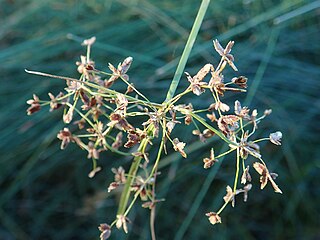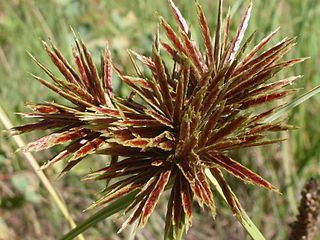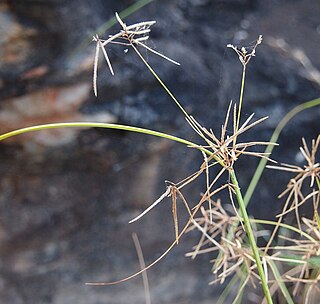Cyperus alterniflorus is a sedge of the family Cyperaceae that is native to Australia.
Cyperus aquatilis is a sedge of the family Cyperaceae that is native to Australia and New Guinea.
Cyperus astartodes is a sedge of the family Cyperaceae that is native to northern parts of Australia.

Cyperus carinatus is a sedge of the family Cyperaceae that is native to northern Australia.
Cyperus castaneus is a sedge of the family Cyperaceae that is native to parts of northern Australia, southern Africa, India, and south east Asia.
Cyperus centralis is a sedge of the family Cyperaceae that is native to arid areas of central Australia.

Cyperus compressus, commonly known as annual sedge, is a sedge of the family Cyperaceae that has a wide distribution throughout countries with warmer climates. It is found in tropical areas of Africa, Asia and the Americas.

Cyperus concinnus is a sedge of the family Cyperaceae that is native to Australia, and found in New South Wales, Queensland, the Northern Territory, South Australia, Victoria and Western Australia.

Cyperus congestus, commonly known as dense flat-sedge or clustered flat-sedge, is a sedge of the family Cyperaceae that is native to southern Africa mostly in South Africa, Lesotho and Namibia.
Cyperus crispulus is a sedge of the family Cyperaceae that is native to Australia and found in Western Australia, and the Northern Territory.
Cyperus cuspidatus, commonly known as the coastal plain flatsedge, is a sedge of the family Cyperaceae that is native to seasonally dry tropical areas of Africa, Asia, the Americas and Australia.

Cyperus dactylotes is a sedge of the family Cyperaceae that is native to all of mainland Australia except for Victoria.
Cyperus digitatus, also known as finger flatsedge in the United States, and chang xiao sui suo cao in China, is a sedge of the family Cyperaceae that is native to tropical and subtropical areas of Africa, Asia, the Americas and Australia.
Cyperus hesperius is a sedge of the family Cyperaceae that is native to Australia.
Cyperus nutans is a sedge of the family Cyperaceae that is native to Australia, China, India, Bangladesh, south-east Asia, Malaysia, India, and Indonesia.
Cyperus pulchellus is a sedge of the family Cyperaceae that is native to northern Australia, tropical Africa, northwest Madagascar and Southeast Asia.
Cyperus tenuispica is a sedge of the family Cyperaceae that is native to seasonally dry tropical areas of Africa, Asia and Australia.

Cyperus vaginatus, commonly known as stiff-leaf sedge or stiff flat-sedge, is a sedge of the family Cyperaceae that is native to Australia.
Cyperus viscidulus is a sedge of the family Cyperaceae that is native to north western Australia.
Cyperus vorsteri is a sedge of the family Cyperaceae native to KwaZulu-Natal in South Africa.






